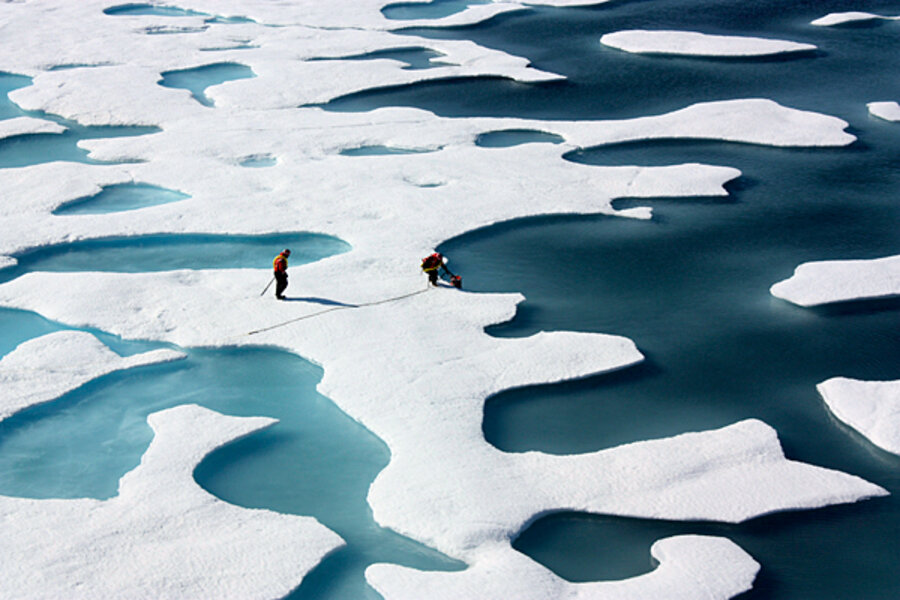Arctic sea ice rebounds, but don't jump to 'global cooling' conclusions
Loading...
After a record-breaking decline in the extent of summer sea ice on the Arctic Ocean last year, this year's minimum has returned to levels that more closely track the long-term rate of decline that scientists have measured for at least 34 years.
The striking one-year recovery in end-of-melt-season ice speaks more to the role that natural variability plays in any single year's number, Arctic sea-ice specialists say. It says little or nothing about any purported global cooling, as some skeptics of climate change have suggested.
Researchers note that the long-term decline in summer sea ice is strongly correlated with rising temperatures in the region, increases they attribute to global warming.
Scientists are keeping close tabs on Arctic sea ice because it plays an important role in the global climate in general and Northern Hemisphere climate in particular. During the summer, when the Arctic landscape is absorbing sunlight and re-radiating it as heat, Arctic sea ice acts as a counterweight. Its white surface reflects sunlight back into space, keeping the region cooler than it might otherwise be.
As summer sea ice declines, sunlight reaches ever-larger patches of ocean to be absorbed and converted to heat. This amplifies the warming that the region experiences. That warming in turn can alter atmospheric circulation patterns at lower latitudes.
Exactly how that happens is still an open question. The National Research Council is sponsoring a meeting on the topic at the University of Maryland in College Park Thursday and Friday. Scientists exploring the issue are slated to review the latest thinking on a warming Arctic's broader atmospheric reach and to try to outline a research agenda to fill gaps in that knowledge.
This year's recovery in summer sea ice at the top of the world is dramatic. On Sept. 16, 2012, parts of the Arctic Ocean containing at least 15 percent sea ice dropped to a record low of 1.32 million square miles.
As of Sept. 9, 2013, sea-ice extent covered 2.35 million square miles of Arctic Ocean, according to data compiled by the National Snow and Ice Data Center in Boulder, Colo. That puts 78 percent more ice on the ocean this month than at the same time last year.
The melt season is not over yet, but typically ends in mid-September.
Despite the impressive one-year recovery, the current sea-ice extent is still nearly 400,000 square miles below the 1981-2010 average minimum. Through August, the long-term decline since 1979, when satellites first began tracking sea-ice extent, has been running at 10.6 percent per decade.
Large portions of the Arctic Ocean remain essentially ice-free. Areas covered by at least 15 percent sea ice are still clinging to the Arctic coast from northern Greenland west through much of the Canadian archipelago.
Despite some media reports of ice stretching in an unbroken expanse from Canada to Russia, the current ice extent appears to be anything but chockablock. Around the perimeter of the Arctic basin, from Canada's western Arctic coast west to northern Scandinavia, large regions of open water remain, particularly along Russia's Arctic coast, according to the latest data from the National Snow and Ice Data Center.
Indeed, through August, Russia reportedly issued permits to more than 400 ships seeking to ply its Northeast Passage, which has been open since July. Chinese cargo ships reportedly have been among the vessels taking advantage of the shortcut from Asia to Europe this year.
Last year's record decline, Arctic specialists have noted, was driven largely by a vast storm in early August that lingered over the central Arctic Ocean. High winds, along with rough seas around the periphery of the ice, sped up the disintegration of large expanses of single-year ice, while rain accelerated surface melting. Single-year ice is thinner and more vulnerable than multi-year ice, whose contribution to Arctic sea ice also has been declining – by at least 15 percent per year by some estimates.
This year, the summer has been 1 to 5 degrees F. cooler from northern Greenland through the North Pole, compared with the 1981-2010 average. Off western Canada's and Alaska's Arctic coasts, temperatures have run about 4 degrees above that average. Perhaps as important, the basin hasn't seen storms anywhere near the strength of last year's August monster.
At the same time, ice volume – combining thickness as well as area – continues to decline, a trend that has been under way since at least 1979. Volume is thought to be a better indicator of climate change than ice extent because it also takes into account the impact of warming ocean waters, which melt the ice from underneath.
Researchers at the University of Washington's Polar Science Center in Seattle who are keeping track of volume are puzzling over an unusually deep dip in estimated sea-ice volume over the past three years.
That dip also appears to be recovering slightly compared with 2012. But the August 2013 estimate remains 66 percent lower than the 1979-2013 average for the month. And it's 76 percent lower than the maximum volume estimated for 1979.
With its sometimes-dramatic yearly ups and downs, the long-term decline in summer sea ice extent and volume continues to raise questions about when the world might expect to see a largely ice-free Arctic each summer.
If wording in the final-draft summary of the next Intergovernmental Panel on Climate Change report on global climate science holds up, it offers that a nearly ice-free Arctic Ocean in September is likely before midcentury.






